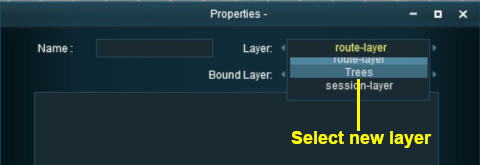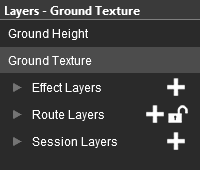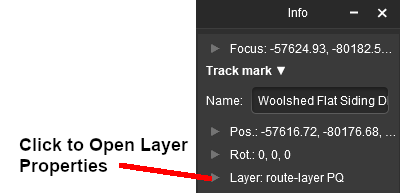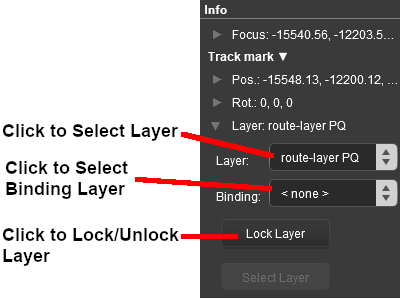How to Use Layers
m (→Moving Objects To Other Layers (S10)) |
m (→What Are Layers?) |
||
| (18 intermediate revisions by one user not shown) | |||
| Line 1: | Line 1: | ||
| − | The information in this Wiki Page applies to '''TANE''', '''TRS19''', '''Trainz Plus''' | + | The information in this Wiki Page applies to '''TANE''', '''TRS19''', '''Trainz Plus''' and '''TRS22'''. |
<table> <!-- BEGIN Nav Buttons Table --> | <table> <!-- BEGIN Nav Buttons Table --> | ||
<tr valign="top"> | <tr valign="top"> | ||
| Line 73: | Line 73: | ||
<td>[[image:PencilTips.PNG|link=]]</td> | <td>[[image:PencilTips.PNG|link=]]</td> | ||
<td>'''Always be aware of which layer is the <span style="font-size: 15px;">Active Layer</span>'''</td> | <td>'''Always be aware of which layer is the <span style="font-size: 15px;">Active Layer</span>'''</td> | ||
| + | </tr> | ||
| + | </table> | ||
| + | </td> | ||
| + | </tr> | ||
| + | </table> | ||
| + | <br> | ||
| + | <table bgcolor="black" width=600> | ||
| + | <tr> | ||
| + | <td> | ||
| + | <table bgcolor=#ffffe0 width=596> | ||
| + | <tr> | ||
| + | <td bgcolor="black" colspan=2> | ||
| + | <span style="font-size: 17px; color: white; font-weight: 700;"> When Creating </span></td> | ||
| + | </tr> | ||
| + | <tr valign="top"> | ||
| + | <td width=25>[[image:PencilTips.PNG|link=]]</td> | ||
| + | <td>'''Place all track and track objects (Track Marks and Triggers can be exceptions) into the <i>route-layer</i> and always keep it as the top level layer'''</td> | ||
| + | </tr> | ||
| + | <tr valign="top"> | ||
| + | <td>[[image:PencilTips.PNG|link=]]</td> | ||
| + | <td>'''For TRS19PE and later, you should place all rolling stock into a session layer to be saved with the session and not the route'''</td> | ||
</tr> | </tr> | ||
</table> | </table> | ||
| Line 122: | Line 143: | ||
<td><span style="font-size: 17px; font-weight: 700;">Effect Layers Notes:'''</span><br> | <td><span style="font-size: 17px; font-weight: 700;">Effect Layers Notes:'''</span><br> | ||
---- | ---- | ||
| − | The special ground effects layers, '''Clutter''', '''TurfFX''' and more recently '''Water''', are not discussed here. In many ways they are more like '''Ground Textures''' but some aspects of their use is similar to the layers covered here. These special ground effects layers are saved as part of a '''Route''' but are not associated with any '''Route Layer'''. | + | The special ground effects layers, '''Clutter''', '''TurfFX''' and more recently '''Water''' and '''Color''', are not discussed here. In many ways they are more like '''Ground Textures''' but some aspects of their use is similar to the layers covered here. These special ground effects layers are saved as part of a '''Route''' but are not associated with any '''Route Layer'''.<br><br> |
| − | </td> | + | The special ground '''Effect Layers''' as used in '''Surveyor 2.0''' are covered in the '''Trainz Wiki Page [[image:WikiLink.PNG|link=]] [[How to Use S20 Tools#skip Effect Layers|How to Use S20 Tools]]'''</td> |
</tr> | </tr> | ||
</table> | </table> | ||
| Line 143: | Line 164: | ||
<tr valign="top"> | <tr valign="top"> | ||
<td>[[image:DotPoint.JPG|10px|link=]]</td> | <td>[[image:DotPoint.JPG|10px|link=]]</td> | ||
| − | <td>'''Effect Layers''' ('''Trainz Plus''' and '''TRS22''') will contain the '''TurfFX''', '''Clutter''' | + | <td>'''Effect Layers''' ('''TRS19''', '''Trainz Plus''' and '''TRS22''') will contain the '''TurfFX''', '''Clutter''', '''Water''' and (in '''Trainz Plus''' routes using '''HD''') '''Color''' effects created using the current route</td> |
</tr> | </tr> | ||
</table> | </table> | ||
| Line 151: | Line 172: | ||
<tr valign="top"> | <tr valign="top"> | ||
<td width=629><span id="stepToolsS10"></span> | <td width=629><span id="stepToolsS10"></span> | ||
| + | |||
='''The Layers Tool in Surveyor Classic (S10)'''= | ='''The Layers Tool in Surveyor Classic (S10)'''= | ||
</td> | </td> | ||
| Line 381: | Line 403: | ||
<tr valign="top"> | <tr valign="top"> | ||
<td width=629><span id="skipCreatingS10"></span> | <td width=629><span id="skipCreatingS10"></span> | ||
| − | |||
=='''Creating a New Route (S10)'''== | =='''Creating a New Route (S10)'''== | ||
</td> | </td> | ||
| Line 658: | Line 679: | ||
<table cellpadding=2 bgcolor=#ffffff> | <table cellpadding=2 bgcolor=#ffffff> | ||
<tr valign="top"> | <tr valign="top"> | ||
| − | <td colspan=2><span style="font-weight: 700; font-size: 15px | + | <td colspan=2><span style="font-weight: 700; font-size: 15px;">Options:</span> Choose one of the following:-</td> |
</tr> | </tr> | ||
<tr valign="top"> | <tr valign="top"> | ||
| Line 687: | Line 708: | ||
<table cellpadding=2 bgcolor=#ffffff> | <table cellpadding=2 bgcolor=#ffffff> | ||
<tr valign="top"> | <tr valign="top"> | ||
| − | <td colspan=2><span style="font-weight: 700; font-size: 15px | + | <td colspan=2><span style="font-weight: 700; font-size: 15px;">Options:</span> Choose one of the following:-</td> |
</tr> | </tr> | ||
<tr valign="top"> | <tr valign="top"> | ||
| Line 1,021: | Line 1,042: | ||
<tr valign="top"> | <tr valign="top"> | ||
<td width=629><span id="skipHidingS10"></span> | <td width=629><span id="skipHidingS10"></span> | ||
| − | |||
=='''Hiding Layers (S10)'''== | =='''Hiding Layers (S10)'''== | ||
</td> | </td> | ||
| Line 1,340: | Line 1,360: | ||
<tr valign="top"> | <tr valign="top"> | ||
<td width=629><span id="stepToolsS20"></span> | <td width=629><span id="stepToolsS20"></span> | ||
| − | |||
='''The Layers Palette in Surveyor 2.0 (S20)'''= | ='''The Layers Palette in Surveyor 2.0 (S20)'''= | ||
</td> | </td> | ||
| Line 1,462: | Line 1,481: | ||
<table bgcolor=#ffffff> | <table bgcolor=#ffffff> | ||
<tr valign="top"> | <tr valign="top"> | ||
| − | <td colspan=2><span style="font-weight: 700; font-size: 15px | + | <td colspan=2><span style="font-weight: 700; font-size: 15px;">Steps:</span> To display palettes:-</td> |
</tr> | </tr> | ||
<tr valign="top"> | <tr valign="top"> | ||
| Line 1,558: | Line 1,577: | ||
<table width=1000> | <table width=1000> | ||
<tr valign="top"> | <tr valign="top"> | ||
| − | <td> | + | <td>You cannot create new layer groups but you can add new layers to a existing group.<br> |
| − | You cannot create new layer groups but you can add new layers to a existing group.<br> | + | Each Layer Group has a [[image:LayerAdd_S20.png|link=]] icon next to its name. <span style="font-weight: 700; font-size: 15px; background-color: lightcyan;">Left Click</span> on the icon to add and name a new layer to that group. If you are adding a new '''Effect Layer''' then you will also have to identify the type of effect - '''TurfFX''', '''Clutter''', '''Water''' or '''Color''' (the '''Color''' effect layer is only visible in <span style="background-color: yellow;">'''HD''' routes created using '''Trainz Plus'''</span>).</td> |
| − | Each Layer Group has a [[image:LayerAdd_S20.png|link=]] icon next to its name. <span style="font-weight: 700; font-size: 15px; background-color: lightcyan;">Left Click</span> on the icon to add and name a new layer to that group. If you are adding a new '''Effect Layer''' then you will also have to identify the type of effect - '''TurfFX''', '''Clutter''' | + | |
</tr> | </tr> | ||
</table> | </table> | ||
<br> | <br> | ||
=='''Renaming a Layer (S20)'''== | =='''Renaming a Layer (S20)'''== | ||
| + | |||
<table width=1000> | <table width=1000> | ||
<tr valign="top"> | <tr valign="top"> | ||
| Line 1,574: | Line 1,593: | ||
<br> | <br> | ||
=='''Deleting a Layer (S20)'''== | =='''Deleting a Layer (S20)'''== | ||
| + | |||
<table width=1000> | <table width=1000> | ||
<tr valign="top"> | <tr valign="top"> | ||
| Line 1,598: | Line 1,618: | ||
<br> | <br> | ||
=='''Moving a Layer (S20)'''== | =='''Moving a Layer (S20)'''== | ||
| + | |||
Layers can be individually moved up and down within the same layer group or between the '''Route Layers Group''' and the '''Session Layers Group'''. <br> | Layers can be individually moved up and down within the same layer group or between the '''Route Layers Group''' and the '''Session Layers Group'''. <br> | ||
<table width=1000 bgcolor=#000000 cellpadding=2> | <table width=1000 bgcolor=#000000 cellpadding=2> | ||
| Line 1,611: | Line 1,632: | ||
<tr valign="top"> | <tr valign="top"> | ||
<td width=10>[[image:DotPoint.JPG|10px|link=]]</td> | <td width=10>[[image:DotPoint.JPG|10px|link=]]</td> | ||
| − | <td>Moving a layer between the '''Session Layer Group''' and the '''Route Layer Group''' will move the layer and its contents between the Route and the Session and this will affect where the layer and its contents are saved</td> | + | <td>Moving a layer between the '''Session Layer Group''' and the '''Route Layer Group''' will move the layer and its contents between the Route and the Session and this will affect where the layer and its contents are saved - in the '''Route''' or in the '''Session'''</td> |
</tr> | </tr> | ||
<tr valign="top"> | <tr valign="top"> | ||
| Line 1,637: | Line 1,658: | ||
</tr> | </tr> | ||
</table> | </table> | ||
| − | + | <br> | |
| − | <table width= | + | <table 1000 bgcolor=#000000 cellpadding=2> |
| + | <tr valign="top"> | ||
| + | <td> | ||
| + | <table width=996 bgcolor=#ffffff cellpadding=2> | ||
<tr valign="top"> | <tr valign="top"> | ||
| − | <td colspan=2><span style="font-weight: 700; font-size: 15px | + | <td colspan=2><span style="font-weight: 700; font-size: 15px;">Steps:</span> To Move a Layer:-</td> |
</tr> | </tr> | ||
| + | <tr valign="top"> | ||
| + | <td width=25>[[image:DotPoint1.JPG|link=]]</td> | ||
| + | <td><span style="font-weight: 700; font-size: 15px; background-color: lightcyan;">Left Click</span> on a layer name</td> | ||
| + | </tr> | ||
| + | <tr valign="top"> | ||
| + | <td>[[image:DotPoint2.JPG|link=]]</td> | ||
| + | <td><span style="font-weight: 700; font-size: 15px; background-color: lightcyan;"> Left Click and Drag </span> the layer up or down to its new position. | ||
| + | <table> | ||
<tr valign="top"> | <tr valign="top"> | ||
<td width=10>[[image:DotPoint.JPG|10px|link=]]</td> | <td width=10>[[image:DotPoint.JPG|10px|link=]]</td> | ||
| Line 1,649: | Line 1,681: | ||
<td>[[image:DotPoint.JPG|10px|link=]]</td> | <td>[[image:DotPoint.JPG|10px|link=]]</td> | ||
<td>the move can be reversed (after it has completed) by using the <span style="font-weight: 700; font-size: 15px; color: white; background-color: black;"> Ctrl </span> <span style="font-weight: 700; font-size: 15px; color: white; background-color: black;"> Z </span> keys</td> | <td>the move can be reversed (after it has completed) by using the <span style="font-weight: 700; font-size: 15px; color: white; background-color: black;"> Ctrl </span> <span style="font-weight: 700; font-size: 15px; color: white; background-color: black;"> Z </span> keys</td> | ||
| + | </tr> | ||
| + | </table> | ||
| + | </td> | ||
| + | </tr> | ||
| + | </table> | ||
| + | </td> | ||
</tr> | </tr> | ||
</table> | </table> | ||
<br> | <br> | ||
| + | <span id="MergeLayersS20"></span> | ||
=='''Merging a Layer (S20)'''== | =='''Merging a Layer (S20)'''== | ||
| + | |||
<table> | <table> | ||
<tr valign="top"> | <tr valign="top"> | ||
| Line 1,684: | Line 1,724: | ||
<br> | <br> | ||
=='''Hiding Layers (S20)'''== | =='''Hiding Layers (S20)'''== | ||
| + | |||
<table width=1000> | <table width=1000> | ||
<tr valign="top"> | <tr valign="top"> | ||
| Line 1,694: | Line 1,735: | ||
<br> | <br> | ||
=='''Locking Layers (S20)'''== | =='''Locking Layers (S20)'''== | ||
| + | |||
<table width=1000> | <table width=1000> | ||
<tr valign="top"> | <tr valign="top"> | ||
| Line 1,734: | Line 1,776: | ||
<br> | <br> | ||
=='''Setting the Active Layer (S20)'''== | =='''Setting the Active Layer (S20)'''== | ||
| − | + | ||
<table width=1000> | <table width=1000> | ||
<tr valign="top"> | <tr valign="top"> | ||
<td>[[image:LayersPalette_S20_ActiveLayer.png|link=|alt=Active layer selected]]</td> | <td>[[image:LayersPalette_S20_ActiveLayer.png|link=|alt=Active layer selected]]</td> | ||
| − | <td>the '''Active Layer''' is the layer where new objects will be automatically added when using the '''Placement Tool'''. The active layer is shown in the palette with its name on a | + | <td>the '''Active Layer''' is the layer where new objects will be automatically added when using the '''Placement Tool''' and pasting or painting a '''Scrapbook'''. The active layer is shown in the palette with its name on a light grey background. In the image on the left the '''Rail Workers''' layer is the current '''Active Layer'''.<br> |
The name of the current '''Active Layer''' is also shown in the '''Layer Palette Title Bar'''.<br> | The name of the current '''Active Layer''' is also shown in the '''Layer Palette Title Bar'''.<br> | ||
| − | To set a new '''Active Layer''', <span style="font-weight: 700; font-size: 15px; background-color: lightcyan;"> | + | To set a new '''Active Layer''', <span style="font-weight: 700; font-size: 15px; background-color: lightcyan;">Left Click</span> on the layer name. |
</td> | </td> | ||
</tr> | </tr> | ||
| Line 1,748: | Line 1,790: | ||
<br> | <br> | ||
=='''Move an Object to a New Layer (S20)'''== | =='''Move an Object to a New Layer (S20)'''== | ||
| − | + | ||
<table cellpadding=2 bgcolor=#ffffff width=1000> | <table cellpadding=2 bgcolor=#ffffff width=1000> | ||
<tr valign="top"> | <tr valign="top"> | ||
| − | <td colspan=2>The '''Info Palette''' will show the layer assigned to the currently selected object. An object is selected by using the '''Free Move Tool''' (the <span style="font-weight:700; font-size: 17px; color: white; background-color: black;"> S </span> key) or the '''Fine Adjustment Tool''' (the <span style="font-weight:700; font-size: 17px; color: white; background-color: black;"> D </span> key) found in the '''Tools Palette'''.<br> | + | <td colspan=2>The '''Info Palette''' will show the layer assigned to the currently selected object. An object is selected by using the '''Free Move Tool''' [[image:S20_FreeMoveToolIcon.png|link=|20px]] (the <span style="font-weight:700; font-size: 17px; color: white; background-color: black;"> S </span> key) or the '''Fine Adjustment Tool''' [[image:S20_FineAdjustmentToolIcon.png|link=|20px]] (the <span style="font-weight:700; font-size: 17px; color: white; background-color: black;"> D </span> key) found in the '''Tools Palette'''.<br> |
<br> | <br> | ||
To the left of the layer name is a small arrow object.</td> | To the left of the layer name is a small arrow object.</td> | ||
| Line 1,764: | Line 1,806: | ||
<tr valign="top"> | <tr valign="top"> | ||
<td>[[image:Tools_S20.png|link=|alt=Tools and keymap for S20]] | <td>[[image:Tools_S20.png|link=|alt=Tools and keymap for S20]] | ||
| − | <table> | + | </td> |
| + | </tr> | ||
| + | </table> | ||
| + | </td> | ||
| + | </tr> | ||
| + | </table> | ||
| + | <br> | ||
| + | <table width=1000 bgcolor=#000000 cellpadding=2> | ||
<tr valign="top"> | <tr valign="top"> | ||
| − | <td width= | + | <td> |
| + | <table width=996 bgcolor=#ffffff cellpadding=2> | ||
| + | <tr valign="top"> | ||
| + | <td colspan=2><span style="font-weight: 700; font-size: 15px;">Steps:</span> To Move an Object to Another Layer:-</td> | ||
| + | </tr> | ||
| + | <tr valign="top"> | ||
| + | <td width=25>[[image:DotPoint1.JPG|link=]]</td> | ||
<td><span style="font-weight: 700; font-size: 15px; background-color: lightcyan;">Left Click</span> the small arrow next to the layer name. This will open the layer properties for the selected object</td> | <td><span style="font-weight: 700; font-size: 15px; background-color: lightcyan;">Left Click</span> the small arrow next to the layer name. This will open the layer properties for the selected object</td> | ||
</tr> | </tr> | ||
<tr valign="top"> | <tr valign="top"> | ||
| − | <td>[[image: | + | <td>[[image:DotPoint2.JPG|link=]]</td> |
| − | <td><span style="font-weight: 700; font-size: 15px; background-color: lightcyan;">Left Click</span> the '''Layer''' drop down box | + | <td><span style="font-weight: 700; font-size: 15px; background-color: lightcyan;">Left Click</span> the '''Layer''' drop down box and <span style="font-weight: 700; font-size: 15px; background-color: lightcyan;">Left Click</span> on the name of the new layer for the object</td> |
</tr> | </tr> | ||
<tr valign="top"> | <tr valign="top"> | ||
| − | <td>[[image: | + | <td colspan=2><span style="font-weight: 700; font-size: 15px;">Optional Steps:</span></td> |
| + | </tr> | ||
| + | <tr valign="top"> | ||
| + | <td>[[image:DotPoint3.JPG|link=]]</td> | ||
<td>if required, <span style="font-weight: 700; font-size: 15px; background-color: lightcyan;">Left Click</span> the '''Binding''' drop down box to select a new binding layer for the object</td> | <td>if required, <span style="font-weight: 700; font-size: 15px; background-color: lightcyan;">Left Click</span> the '''Binding''' drop down box to select a new binding layer for the object</td> | ||
</tr> | </tr> | ||
<tr valign="top"> | <tr valign="top"> | ||
| − | <td>[[image: | + | <td>[[image:DotPoint4.JPG|link=]]</td> |
| − | <td>if required, <span style="font-weight: 700; font-size: 15px; background-color: lightcyan;">Left Click</span> the <span style="font-weight: 700; font-size: 17px; color: white; background-color: black;">  | + | <td>if required, <span style="font-weight: 700; font-size: 15px; background-color: lightcyan;">Left Click</span> the <span style="font-weight: 700; font-size: 17px; color: white; background-color: black;"> Select Layer </span> button to set this layer as the '''Active Layer'''. If the layer is already the '''Active Layer''' then this button will be greyed out and cannot be selected</td> |
</tr> | </tr> | ||
| − | </ | + | <tr valign="top"> |
| − | </td> | + | <td>[[image:DotPoint5.JPG|link=]]</td> |
| + | <td>if required, <span style="font-weight: 700; font-size: 15px; background-color: lightcyan;">Left Click</span> the <span style="font-weight: 700; font-size: 17px; color: white; background-color: black;"> Lock Layer </span> button to lock the selected layer. If the layer is already locked then this will be shown as an <span style="font-weight: 700; font-size: 17px; color: white; background-color: black;"> Unlock Layer </span> button and can be clicked to unlock the layer</td> | ||
</tr> | </tr> | ||
</table> | </table> | ||
| Line 1,788: | Line 1,847: | ||
</tr> | </tr> | ||
</table> | </table> | ||
| − | + | <br> | |
<table> <!-- BEGIN Nav Buttons Table --> | <table> <!-- BEGIN Nav Buttons Table --> | ||
<tr valign="top"> | <tr valign="top"> | ||
| Line 1,945: | Line 2,004: | ||
<tr valign="top"> | <tr valign="top"> | ||
<td>[[image:DotPoint.JPG|10px|link=]]</td> | <td>[[image:DotPoint.JPG|10px|link=]]</td> | ||
| − | <td>A '''Ruler Layer''' if you are using rulers. | + | <td>A '''Ruler Layer''' if you are using rulers. Rulers obey layer behavior (lock and hide) just like all other objects and splines. In '''Surveyor Classic''' they have no properties window to show their layer or allow you to change that layer. Consider placing all '''Surveyor Classic''' rulers in a dedicated layer to make their management easier. <span style="background-color: red; color: white; font-weight: 700;"> NOTE: </span> Due to a bug in TANE/TRS19, deleting a dedicated '''Ruler Layer''' will not delete the rulers but will '''temporarily''' hide them from view. Rulers will still have to be deleted individually.<br> |
| + | In '''Surveyor 2.0''' these issues have been overcome and rulers are '''Spline Objects''' and have all the properties of splines.</td> | ||
</tr> | </tr> | ||
</table> | </table> | ||
| Line 2,179: | Line 2,239: | ||
</table> | </table> | ||
<br> | <br> | ||
| − | This is a little used and probably little understood layer feature. It allows you to attach an object to two different layers so it can have the properties (locked/unlocked and show/hide) of both layers. The bound/binding layer was introduced as a development tool, its sole use is as a tool in the building of routes and sessions. | + | <table width=1000> |
| − | + | <tr valign="top"> | |
| + | <td>This is a little used and probably little understood layer feature. It allows you to attach an object to two different layers so it can have the properties (locked/unlocked and show/hide) of both layers. The bound/binding layer was introduced as a development tool, its sole use is as a tool in the building of routes and sessions.</td> | ||
| + | </tr> | ||
| + | </table> | ||
| + | <br> | ||
<table width=1000 bgcolor="lightcyan" cellpadding=2> | <table width=1000 bgcolor="lightcyan" cellpadding=2> | ||
<tr valign="top"> | <tr valign="top"> | ||
| Line 2,263: | Line 2,327: | ||
<td width=10>[[image:DotPoint.JPG|10px|link=]]</td> | <td width=10>[[image:DotPoint.JPG|10px|link=]]</td> | ||
<td bgcolor="lightcyan">If the '''Assigned Layer''' or the '''Bound/Binding Layer''' of an object is '''Hidden''' then the object will be '''Hidden'''</td> | <td bgcolor="lightcyan">If the '''Assigned Layer''' or the '''Bound/Binding Layer''' of an object is '''Hidden''' then the object will be '''Hidden'''</td> | ||
| + | </tr> | ||
| + | </table> | ||
| + | <br> | ||
| + | <table width=550 bgcolor=#000000 cellpadding=2> | ||
| + | <tr valign="top"> | ||
| + | <td> | ||
| + | <table bgcolor=#ffffe0 cellpadding=2> | ||
| + | <tr valign="top"> | ||
| + | <td width=25>[[image:PencilTips.PNG|link=]]</td> | ||
| + | <td>In '''Surveyor 2.0''' you can also use the asset filters found in the <span style="font-weight: 700; font-size: 15px; color: white; background-color: #797979;"> Filter Palette </span> and the <span style="font-weight: 700; font-size: 15px; color: white; background-color: #797979;"> Assets Palette </span> to lock or hide specific assets or types of assets from selection when you are working in Surveyor. See the section [[image:WikiLink.PNG|link=]] '''[[How_to_Use_S20_Tools#Narrowing the Search|S20 Tools - Narrowing the Search]]''' for more details</td> | ||
| + | </tr> | ||
| + | </table> | ||
| + | </td> | ||
</tr> | </tr> | ||
</table> | </table> | ||
| Line 2,433: | Line 2,510: | ||
</tr> | </tr> | ||
<tr valign="top"> | <tr valign="top"> | ||
| − | <td colspan=2>Select an object, or a group of objects, using either the '''Free Move Tool''' or the '''Fine Adjustment Tool'''. In the '''Info Palette''' of the object (or the last selected object):-</td> | + | <td colspan=2>Select an object, or a group of objects, using either the '''Free Move Tool''' [[image:S20_FreeMoveToolIcon.png|link=|20px]] or the '''Fine Adjustment Tool''' [[image:S20_FineAdjustmentToolIcon.png|link=|20px]]. In the '''Info Palette''' of the object (or the last selected object):-</td> |
</tr> | </tr> | ||
<tr valign="top"> | <tr valign="top"> | ||
| Line 2,521: | Line 2,598: | ||
=='''Using a Driver Command'''== | =='''Using a Driver Command'''== | ||
The driver command [[image:WikiLink.PNG|link=]] '''[[Driver_Commands_List#Layer_Control|Layer Control]]''' hides and shows named layers.<br> | The driver command [[image:WikiLink.PNG|link=]] '''[[Driver_Commands_List#Layer_Control|Layer Control]]''' hides and shows named layers.<br> | ||
| − | [[image:LayerControlExample.png|link=]]< | + | <table width=1000> |
| − | + | <tr valign="top"> | |
| + | <td>[[image:LayerControlExample.png|link=]]</td> | ||
| + | <td> | ||
| + | <table bgcolor=#000000 cellpadding=2> | ||
| + | <tr valign="top"> | ||
| + | <td> | ||
| + | <table bgcolor=#ffffff cellpadding=2> | ||
| + | <tr valign="top"> | ||
| + | <td colspan=2>The sequence of events in this example will be:-</td> | ||
| + | </tr> | ||
| + | <tr valign="top"> | ||
| + | <td width=25>[[image:DotPoint1.JPG|link=]]</td> | ||
| + | <td>The train will drive to the named station</td> | ||
| + | </tr> | ||
| + | <tr valign="top"> | ||
| + | <td>[[image:DotPoint2.JPG|link=]]</td> | ||
| + | <td>It will wait for 30 seconds</td> | ||
| + | </tr> | ||
| + | <tr valign="top"> | ||
| + | <td>[[image:DotPoint3.JPG|link=]]</td> | ||
| + | <td>The assets held in or bound to the named layer will be hidden from view (or shown)</td> | ||
| + | </tr> | ||
| + | </table> | ||
| + | </td> | ||
| + | </tr> | ||
| + | </table> | ||
| + | </td> | ||
| + | </tr> | ||
| + | </table> | ||
| + | <br> | ||
=='''Using Session Rules'''== | =='''Using Session Rules'''== | ||
<br> | <br> | ||
| Line 2,599: | Line 2,705: | ||
<td> | <td> | ||
<span style="font-size: 17px;">'''More Tutorials and Guides to Using Trainz'''</span><br> | <span style="font-size: 17px;">'''More Tutorials and Guides to Using Trainz'''</span><br> | ||
| − | *'''<span class=" | + | *'''<span class="plain;s">[http://online.ts2009.com/mediaWiki/index.php/HowTo How to Guides]</span>''' |
*'''[[Driver Commands List]]''' | *'''[[Driver Commands List]]''' | ||
*'''[[Session Rule List with Parameters|Session Rules List (Alphabetical) with Parameters]]''' | *'''[[Session Rule List with Parameters|Session Rules List (Alphabetical) with Parameters]]''' | ||
| Line 2,607: | Line 2,713: | ||
</table> | </table> | ||
---- | ---- | ||
| − | This page was created by Trainz user '''<span class=" | + | This page was created by Trainz user '''<span class="plain;s">[http://online.ts2009.com/mediaWiki/index.php/User:Pware pware]</span>''' in June 2018 and was last updated as shown below. |
---- | ---- | ||
[[Category:How-to guides]] | [[Category:How-to guides]] | ||
Latest revision as of 12:56, 28 September 2024
The information in this Wiki Page applies to TANE, TRS19, Trainz Plus and TRS22.
[edit] What Are Layers? |
| Layers are a Surveyor tool that allows you to better manage the objects that are placed in your Trainz World. | |
| Layers are a Driver tool that allows you to change what the players see as they drive around your Trainz World. |
| Layers can contain any objects, visible and invisible, that can be placed into a layout in Surveyor Classic using the Object, Track and Train tools or using the Placement Tool in Surveyor 2.0. The layers and their contents can be hidden from view (in both Surveyor and in Driver) or locked against alteration whenever required. Their main use is in the development of a Route and a Session but they can also be used as a way of providing some additional novelty during a Driver session. |
|
Almost all of what you will see in a Trainz World will be found in layers, and mostly in the Route Layers and Session Layers.
| Route Layers will contain the objects that will appear in ALL the sessions created using the current route | |
| Session Layers will contain the objects that will only appear in the current session | |
| Effect Layers (TRS19, Trainz Plus and TRS22) will contain the TurfFX, Clutter, Water and (in Trainz Plus routes using HD) Color effects created using the current route |
[edit] The Layers Tool in Surveyor Classic (S10) |
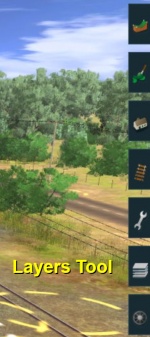 |
 |
Left Click the Layers Tool (or press F6 ) to open up its properties.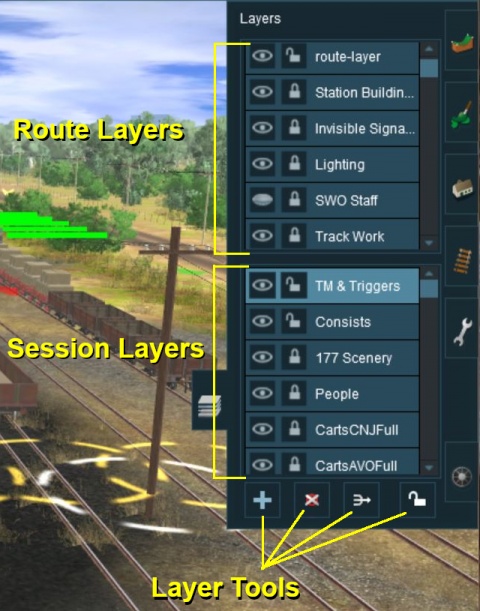 |
|
[edit] Loading a Route and Loading a Session (S10) |
| Route Layers are saved with the Route. Session Layers are saved with the Session | |
| If you edit a Session Layer and later load just the Route then those edits will not appear. |
 |
More information on creating, loading and saving Routes and Sessions can be found on the Trainz Wiki Page at Route and Session Basics |
The layers you see will depend on whether you have loaded a Route by itself (with no "child" Session) or a Session and its "parent" Route.
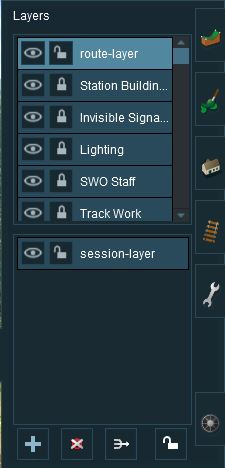 |
 |
The first image on the left gives an example of the layers that can appear if a Route only is loaded into Surveyor. These are the layers that are saved with the Route. Note that a default "session-layer" is present.
The second image on the left gives an example of the layers that can appear if a Session based on that Route is loaded into Surveyor. It shows Route Layers and Session Layers. In both cases, the Route Layers are identical because the same Route has been loaded. A Session contains its own layers, the Session Layers, that are loaded and saved with the Session but are not loaded or saved with the Route.
|
|
[edit] Creating a New Route (S10) |
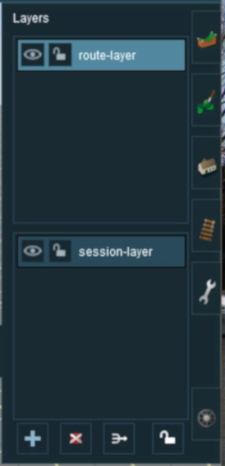 |
|
|||||||||||
[edit] The "Active Layer" (S10) |
| The Active Layer is the selected (highlighted) layer | |
| When you load the Route only into Surveyor, the first Route layer will be the Active Layer | |
| When you load a Session into Surveyor, the first Session layer will be the Active Layer |
| In the image above, the route-layer is the Active Layer. You can change the Active Layer at any time by a Left Click on the name of another layer. |
|
|
||||||||||||
[edit] Adding a New Layer (S10) |
| Left Click the Add Button |
An Add layer dialogue window will appear.
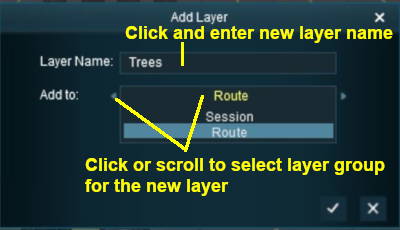 |
|
||||||||||||
[edit] Deleting a Layer (S10) |
|
| Select the layer to be deleted and Left Click on the Delete Button. If you don't select a layer to delete then Trainz will select the current Active Layer. |
|
If the layer being deleted is empty, then the following dialogue window will appear:-
 |
|
|||||||
If the layer being deleted is NOT empty, then the following dialogue window will appear:-
 |
|
|||||||||
[edit] Merging Layers (S10) |
| Merging a layer into another layer will move ALL the objects from the first layer into the second layer. The first layer, which is now empty, will then be deleted | |
| Once layers have been merged they cannot be separated. |
|
| Select the layer to be merged into another layer and Left Click the Merge button. If you don't select a layer to merge then Trainz will select the current Active Layer. |
|
The layer merge dialogue window will appear as shown below:-
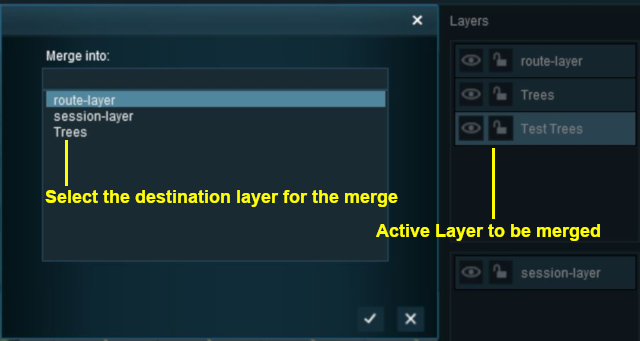 |
|
|||||||||
[edit] Locking Layers (S10) |
| If you LOCK or UNLOCK a Route Layer while editing a Session then you will have made a change to the Route and will be asked to save both the Route and the Session when you exit Surveyor |
|
[edit] Locking Individual Layers (S10)
| The objects in a LOCKED layer cannot be moved (around the layout) or deleted but they can be moved to other layers. |
To LOCK an individual layer, Left Click on the ![]() Open Padlock icon next to its name. The layer being locked does not have to be the current Active Layer.
Open Padlock icon next to its name. The layer being locked does not have to be the current Active Layer.
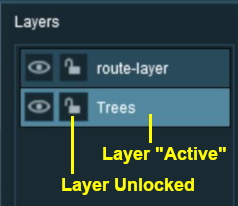 |
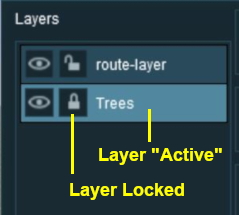 |
|
If you attempt to add a scenery object to a locked layer you will receive the following message:-
 |
Left Click on the Left Click on the |
[edit] Locking ALL Route Layers (S10)
| Left Click on the Lock Button |
This will LOCK ALL the layers in the Route Layers Group. The Session Layers Group will not be affected.
The Route Layers Group can be UNLOCKED by a Left Click on the Lock Button again.
[edit] Moving a Layer (S10) |
| Layers can be moved up or down within the same layer group (e.g. Route or Session) or between the two groups | |
| Track Objects (signals, switches, etc) should be in the same layer as the Track or in a layer below the Track layer |
|
In the example shown below a layer created in the Route Layers Group is being moved into the Session Layers Group.
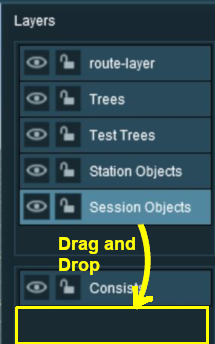 |
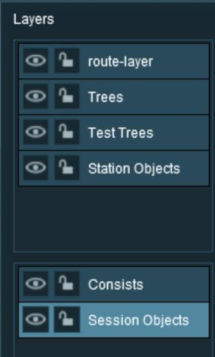 |
|
|||||||||||||||||||||
[edit] Hiding Layers (S10) |
To hide or show a layer Left Click the Eye Icon next to its name.
 |
In the image shown left the two trees are in different Route Layers and all the layers have their |
|||||||
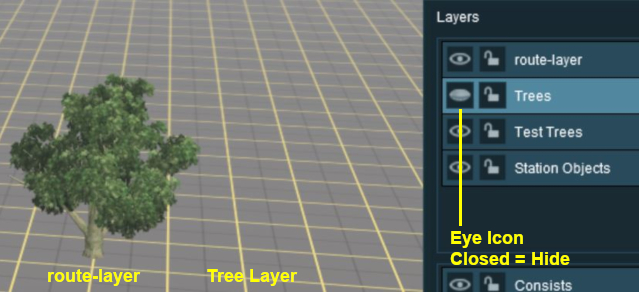 |
In the image shown left the Trees layer has its
|
[edit] Adding Objects To Layers (S10) |
| When an object (such as a scenery item, consist, track or track object) is added to the layout it is automatically placed in the currently Active Layer. Unfortunately, Surveyor Classic (S10) does not indicate which layer is the Active Layer unless you open the Layers Tool to look. This can lead to objects being placed into the wrong layers and while these objects can later be moved to another layer (see the section |
|
| You cannot add objects to a layer that is LOCKED |
If you attempt to add a scenery object to a locked layer you will receive the following message:-
 |
Left Click on the Left Click on the |
| When adding track objects (signals, speed signs, etc) to a track, the objects being added must be in the same layer as the track or in a layer below the track layer. For more information, see the section |
|
[edit] Deleting Objects From Layers (S10) |
| You cannot delete objects from a layer that is LOCKED |
|
Unfortunately Trainz does not give you a warning message when you attempt to delete an object from a locked layer, the object just refuses to be deleted.
|
[edit] Moving Objects To Other Layers (S10) |
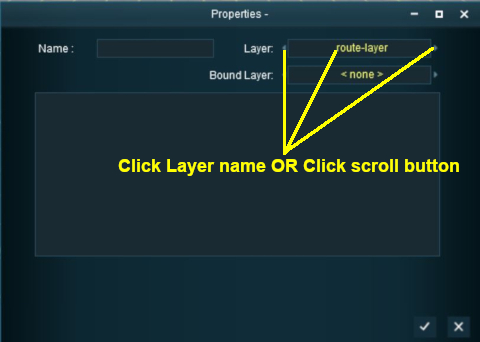
|
|
|||||||||||||||||||||
[edit] The Layers Palette in Surveyor 2.0 (S20) |
|
Layers are found in the Layers Palette.
|
|
|||||||||||||||||||||||||||||||||||||||||||||||
[edit] Lock the Route Layer Group (S20)
All the layers in the Route Layer Group can be locked against accidental alteration.
|
||||||
[edit] Open a Layer Group (S20)
To the left of each Layer Group name is a small arrow. Left Click on the arrow to open up the group.
 |
The image on the left shows that the Session Layers Group is open and its individual layers are now displayed. To close or minimise the group Left Click on the arrow again.
|
||||||||
[edit] Add a New Layer (S20)
| You cannot create new layer groups but you can add new layers to a existing group. Each Layer Group has a |
[edit] Renaming a Layer (S20)
 |
Right Click on a layer name and select Rename Layer.. from the popup menu. You will be asked to enter a new name for the layer. |
[edit] Deleting a Layer (S20)
 |
Right Click on a layer name and select Delete Layer from the popup menu. You will be given a warning that you are about to delete a layer.
|
[edit] Moving a Layer (S20)
Layers can be individually moved up and down within the same layer group or between the Route Layers Group and the Session Layers Group.
|
|
||||||||||
[edit] Merging a Layer (S20)
 |
Right Click on a layer name and select Merge Layer Up from the popup menu.
|
[edit] Hiding Layers (S20)
|
Each individual layer has an Eye icon that controls the visible state of that layer. Left Click on the icon to toggle its state between visible and hidden. If the Eye is:-
|
[edit] Locking Layers (S20)
|
Each individual layer has a Padlock icon that controls the state (
|
|
[edit] Setting the Active Layer (S20)
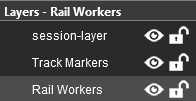 |
the Active Layer is the layer where new objects will be automatically added when using the Placement Tool and pasting or painting a Scrapbook. The active layer is shown in the palette with its name on a light grey background. In the image on the left the Rail Workers layer is the current Active Layer. The name of the current Active Layer is also shown in the Layer Palette Title Bar. To set a new Active Layer, Left Click on the layer name. |
[edit] Move an Object to a New Layer (S20)
| The Info Palette will show the layer assigned to the currently selected object. An object is selected by using the Free Move Tool
|
||
|
|
|
|
|
||||||||||||||
[edit] Route Layers vs Session Layers |
This topic has filled endless threads in the Trainz Forums with arguments raging on both sides.
| In general, there are no "cast iron" rules that dictate what should be placed in the Route Layers Group and what should be placed in the Session Layers Group (for an exception see TRS19 Platinum Edition, Trainz Plus, TRS22 Notes below) |
| Each Route and Session will be different and different creators have different ways of working. The main question to be asked is how many different Sessions will be created using a particular Route? |
Notes:
|
TRS19 Platinum Edition, Trainz Plus, TRS22 Notes:
|
|||||||||
[edit] The Route Layers Group |
| The Route Layer Group should be used for everything that will always appear in Driver Mode regardless of which Session is playing. |
| There is nothing stopping you from placing everything in the "route-layer" of the Route Layers Group and never having to worry about dealing with layers ever again - some creators prefer to work this way. However, layers do provide you with a way of organising your scenery objects to make them more manageable, particularly in more complicated layouts.
|
|||||||||||||
|
[edit] The "route-layer"
| To avoid any confusion over which layer is the original "route-layer", this is one layer that should not be renamed or moved from the top position |
While all layers are equal, the "route-layer" is special.
|
|
||||||||||||
[edit] The Session Layers Group |
| The Session Layers Group should be used for everything that will only be seen in the currently loaded Session. |
If you are creating more than one Session based around a particular Route, then you will probably make use of the Session Layers.
|
|
[edit] The "session-layer"
|
|
|||||||||
[edit] The Bound Layer |
| In Trainz Plus and TRS22 the Bound Layer is often referred to as the Binding Layer |
| This is a little used and probably little understood layer feature. It allows you to attach an object to two different layers so it can have the properties (locked/unlocked and show/hide) of both layers. The bound/binding layer was introduced as a development tool, its sole use is as a tool in the building of routes and sessions. |
| An object will be LOCKED and cannot be deleted or moved if its layer OR its bound/binding layer is locked. | |
| An object will be HIDDEN if its layer OR its bound/binding layer is hidden. | |
| Rulers cannot be bound to another layer. |
|
|
|||||||||||||||||||||||||||||||||||||||||||
|
|
||||||||||
|
[edit] Setting an Object to the Bound Layer in Surveyor Classic (S10) |
 |
|
||||||||||
| When a layer is deleted any objects bound to that layer will have their Bound Layer reset to <none> |
[edit] Setting an Object to the Bound Layer in Surveyor 2.0 (S20) |
|
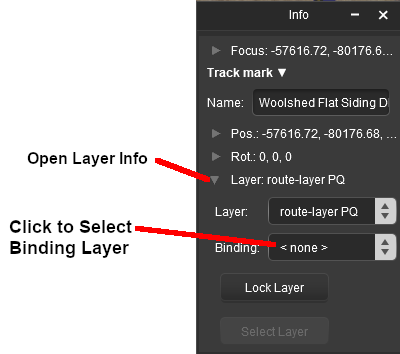 |
|
|||||||||||||
| When a layer is deleted any objects bound to that layer will have their Bound Layer reset to <none> |
[edit] Layers in Driver Mode |
During the running of a Session in Driver Mode visible layers can be hidden and invisible layers revealled according to the events that occur during the Session.
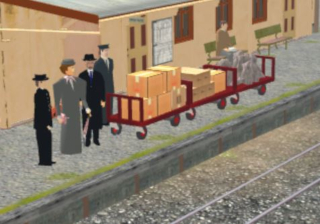 |
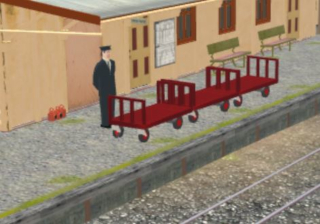 |
The two Driver Mode scenes shown on the left illustrate this feature.
|
|||||||
| This effect could be achieved in two different ways:- | |
| A Driver Command - specific to a particular driver, or | |
| A Session Rule - specific to a particular driver, consist, or any driver/consist | |
[edit] Using a Driver Command
The driver command Layer Control hides and shows named layers.
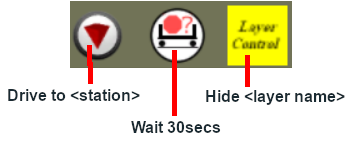 |
|
|||||||||
[edit] Using Session Rules
 |
Rules Used: |
- Trackside Check Rule - to trigger the event
- Show/Hide Layer Rule - to hide layers
- Message Popup Rule - to open a browser window with a message
 |
Session Editor Screenshot: |
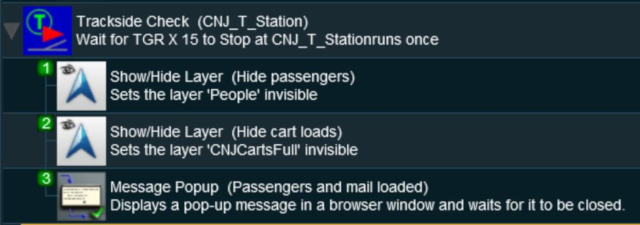 |
 |
Description: |
| In this example:- | ||||||
The Trackside Check Rule is triggered when a specific train comes to a stop at a trackmark. This then executes the following rules in order:-
|
||||||
[edit] Trainz Wiki
 |
More Tutorials and Guides to Using Trainz |
This page was created by Trainz user pware in June 2018 and was last updated as shown below.
